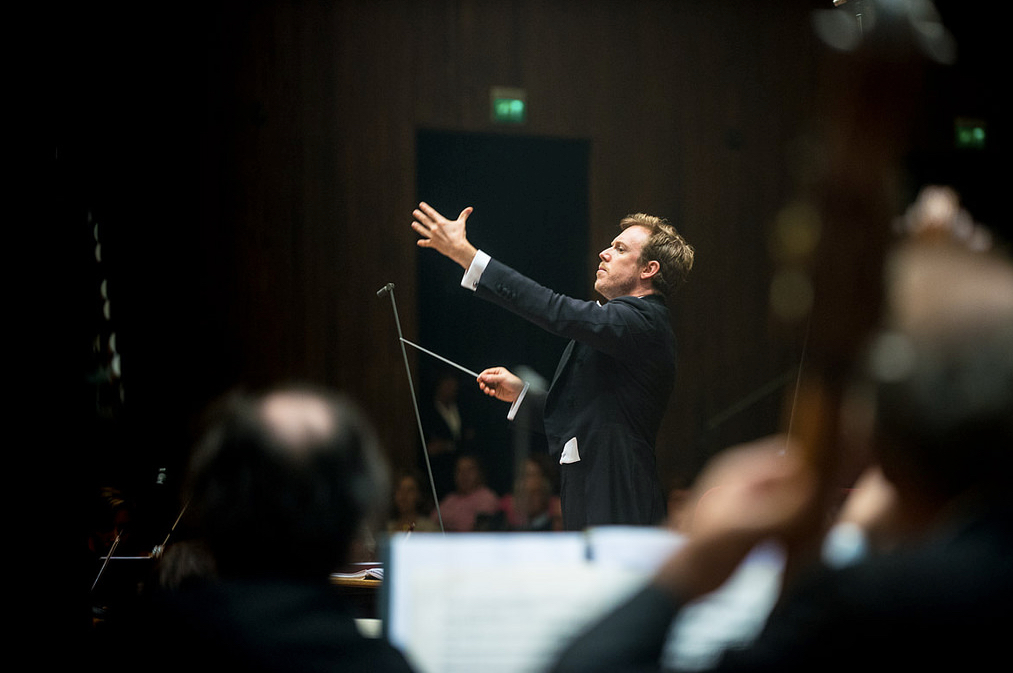Review: Le ambiguità risolte del Romanticismo
Quarantenne da una settimana, il 6 settembre Daniel Harding ha diretto la Filarmonica della Scala al Conservatorio di Milano, in una domenica dal programma austroungarico – viennese di adozione Beethoven, boemo Dvorak -, incastrata tra due eventi pietroburghesi: Temirkanov il 5 alla Scala e Gergiev il 7 sempre al Conservatorio. Questo lo straordinario terzetto di apertura di MITO 2015.
Una serata che divaga attraverso l’arco intero del romanticismo ottocentesco, dall’intuizione beethoveniana del Terzo concerto per pianoforte e orchestra, all’Ottava sinfonia di Dvorak, la più slava di tutte.
Alessandro Taverna, veneto, classe ’83, è il brillante solista della prima parte, dal suono intelligente ed equilibrato. Un pianista che sa riconoscere la cifra tonda della data di pubblicazione del concerto di Beethoven: 1800, un anno che sta molto più indietro di quanto sembri, nonostante l’urgenza del compositore di mettere in discussione le tradizioni.
Insofferente alle rassicuranti forme di routine, Beethoven sa che, per citare Hölderlin, solo «dove c’è il pericolo cresce anche la salvezza»: da qui il suo coraggio della novità, del cambiamento e, perché no, della verità, come dirà Foucault nel secolo successivo.
Ed è proprio sull’ambiguità di tale capolavoro, su questo stile che è come se sintetizzasse un’indecisione sul da farsi, che si erge sicura e cristallina l’interpretazione di Taverna. Inoltre l’intelligenza interpretativa del pianista ha mostrato una straordinaria verve, in particolare nella fuga finale delle Variazioni Telemann di Max Reger, virtuosistico bis che congiunge barocco e tardoromanticismo, contrappunto e armonie estreme.
Quanto a Harding, per la prima volta pareva faticare a contenersi, e in molti dei passaggi più voluminosi il grande direttore inglese ha in parte offuscato la sua elegante morbidezza, il suo fraseggio docile e affabile. Il quale però è riemerso splendidamente nei tempi centrali della sinfonia di Dvorak, in cui Harding danzava letteralmente sul podio, in luminosa sintonia con l’orchestra. In particolare «grazioso» è persino eufemistico, se si vuole aggettivare l’Allegretto grazioso – appunto – che Dvorak ha scritto al posto del tipico Scherzo sinfonico: un oscillante ritmo di valzer con un’intrinseca inquietudine sotterranea che Harding ha smosso col suo gesto. A sorpresa, come encore, il più grande poema sinfonico italiano: l’ouverture del Guglielmo Tell di Rossini.
(Translation) Forty-year-old since last week, on 6th September Daniel Harding conducted La Scala Philharmonic at Milan Conservatory, in a Sunday with an Austro-Hungarian program – Beethoven was Viennese-adoptive, while Dvorak was Bohemian -, stuck between two Petersburgers events: Temirkanov at La Scala on the 5th and Gergiev on the 7th again at the Conservatory. This was the extraordinary opening threesome of MITO 2015.
An evening that wanders through the entire arch of the Nineteenth Century Romanticism, from Beethoven’s intuition in the Third Concerto for Piano and Orchestra, to the Eighth Symphony by Dvorak, the most Slavic one.
Alessandro Taverna, Venetian, born in 1983, is the brilliant soloist of the first part, with an intelligent and balanced sound. A pianist who is able to recognize the round figure of the date of publication of this Beethoven concerto: 1800, a year that is much further back than it sounds, despite the urgency of the composer to question traditions.
Intolerant to the routinely reassuring forms, Beethoven knows that, to quote Hölderlin, only “where there is the danger it grows also the salvation”: hence his courage in innovation, in change and, why not, in truth, as Foucault will say in the next century.
And it is precisely on the ambiguity of this masterpiece, on this style which is as if it synthesizes an indecision about what to do, that the interpretation of Taverna stands out safe and clear. Furthermore, the interpretive intelligence of pianist showed an extraordinary verve, particularly in the final Fugue from “Telemann Variations” by Max Reger, a virtuoso encore which joins the baroque era and the late Romanticism, counterpoint and extreme harmonies.
As for Harding, for the first time he seemed to struggle to contain himself, and in many more voluminous passages the great English conductor has partly overshadowed his elegant smoothness, his docile and affable phrasing. Which, however, it has beautifully resurfaced in the central movements of the Dvorak Symphony, where Harding literally danced on the podium, in bright harmony with the orchestra. In particular, “grazioso” it is even euphemistic, if we want find and adjective to the “Allegretto Grazioso” – in fact – that Dvorak wrote instead of the typical symphonic Scherzo: a swinging waltz rhythm with an inherent and hiden restlessness which Harding turned over with his gesture. Surprisingly, as an encore, the largest Italian symphonic poem: the overture from William Tell by Rossini.
Immagine di copertina: Giorgio Gori per MiTo SettembreMusica
http://www.cultweek.com/le-ambiguita-risolte-del-romanticismo/
-
Recent News
- Video: Britten Piano Concerto – Dallas Symphony Orchestra (YouTube) 26 January, 2024
- Video: San Carlo, magia sinfonica (RAI TGR Campania) 1 January, 2024
- Review: Il rigore e la passione di Dego e Taverna (Il portale del violino) 18 December, 2023
- Review: Taverna, Ceretta e ORT (DeArtes) 11 December, 2023
- Review: Diego Ceretta con Alessandro Taverna e l’Orchestra della Toscana (Operaclick) 5 December, 2023
- Review: Angius, Taverna e l’OPV omaggiano Malipiero (Il Giornale della Musica) 24 November, 2023
- Review: Yutaka Sado and the DSO brilliantly deliver a fresh program (Dallas Morning) 18 November, 2023
- Review: Il Verdi di Trieste infiamma il pubblico (Musica) 11 October, 2023
- Review: Trieste, Teatro Verdi: Sesto concerto della stagione sinfonica (Operaclick) 9 October, 2023
- Interview: A Portogruaro la musica è multiverso (Il Giornale della Musica) 21 August, 2023
- Review: Colori Russi (L’Ape Musicale) 28 July, 2023
- Review: Torre del Lago, Concerto diretto da Gianandrea Noseda con Alessandro Taverna (OperaClick) 24 July, 2023
Latest tweets
Recent News
- Video: Britten Piano Concerto – Dallas Symphony Orchestra (YouTube)
- Video: San Carlo, magia sinfonica (RAI TGR Campania)
- Review: Il rigore e la passione di Dego e Taverna (Il portale del violino)
- Review: Taverna, Ceretta e ORT (DeArtes)
- Review: Diego Ceretta con Alessandro Taverna e l’Orchestra della Toscana (Operaclick)

